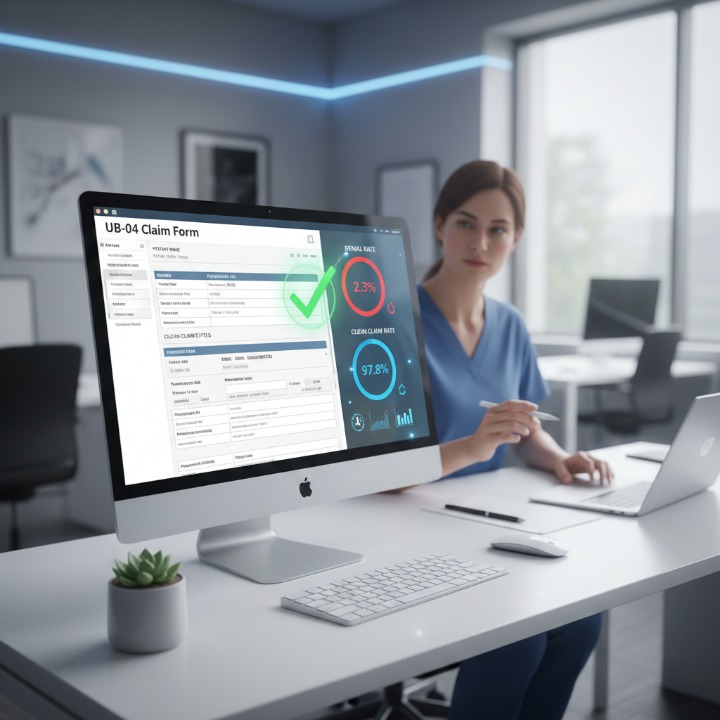Telehealth Medical Billing 2025 has evolved from a pandemic necessity to a permanent fixture in healthcare delivery. As we move through 2025, the impact on medical billing and coding practices continues to deepen, creating both opportunities and challenges for healthcare organizations. By 2025, telehealth visits are projected to exceed 1 billion annually, according to a report by McKinsey, fundamentally reshaping how medical services are documented, coded, and reimbursed.
This transformation extends far beyond simple virtual consultations. The integration of artificial intelligence, evolving regulatory frameworks, and new reimbursement models is creating a complex landscape that requires careful navigation. For medical billing professionals, healthcare administrators, and technology providers, understanding these changes is crucial for maintaining compliance and optimizing revenue cycles.
The Current State of Telehealth Medical Billing 2025 Challenges
Medical billing has always been complex, but telehealth has introduced new layers of complexity that many organizations are still learning to navigate. Traditional billing workflows were designed around in-person visits with standardized documentation patterns and predictable coding scenarios.
The shift to virtual care has disrupted these established patterns. A recent survey by the American Medical Billing Association (AMBA) found that 75% of medical billers report challenges in coding for telehealth services. These challenges stem from several factors: the need to distinguish between different types of virtual encounters, the proper application of modifiers, and ensuring compliance with varying state and federal regulations.
One of the most significant challenges lies in the complexity of telehealth billing requirements. Unlike traditional face-to-face encounters, telehealth visits require careful attention to the technology used, the location of both patient and provider, and the specific services rendered. Audio-only services, for instance, have different coding requirements than audio-video encounters, and these distinctions can significantly impact reimbursement.
The COVID-19 pandemic initially provided telehealth flexibilities that simplified many of these processes. However, as these temporary measures have evolved into permanent policies, organizations must adapt to a more structured regulatory environment while maintaining the accessibility that telehealth provides.
How Telehealth Medical Billing 2025 is Reshaping Medical Coding Practices
The coding landscape for telehealth services has undergone substantial changes, with new codes, modifiers, and documentation requirements emerging regularly. The Centers for Medicare & Medicaid Services (CMS) has expanded telehealth coverage to include over 200 additional services, fundamentally altering billing and coding practices across healthcare organizations.
Updated CPT Guidelines and E/M Changes in Telehealth Medical Billing 2025
Evaluation and management (E/M) codes have seen significant updates to accommodate virtual care delivery. These changes reflect the unique nature of telehealth encounters and the different levels of complexity involved in virtual patient assessment. Established patient visits conducted via telehealth now have specific coding pathways that differ from traditional in-person encounters.
The introduction of new CPT codes specifically designed for telehealth services has created additional revenue opportunities while requiring careful attention to proper application. These codes often have specific requirements regarding the technology used, the duration of the encounter, and the type of services provided.
Remote Patient Monitoring Challenges in Telehealth Medical Billing 2025
Remote patient monitoring (RPM) services represent one of the most challenging areas in telehealth billing. These services involve continuous monitoring of patient data outside traditional healthcare settings, requiring specific documentation and coding protocols. The challenge lies in properly capturing the scope of services provided, from device setup and patient education to data analysis and clinical interventions.
RPM services often span multiple days or weeks, requiring careful coordination between billing and clinical teams to ensure all services are properly documented and coded. The complexity increases when considering that different types of monitoring equipment and services may require different coding approaches.
Modifier Applications and Compliance Issues
The correct application of modifiers in telehealth billing remains a significant challenge for many organizations. Modifier 95 is commonly used for synchronous telehealth services, but its proper application requires an understanding of when services qualify for this designation. Audio-only telehealth services may require different modifier applications, and the distinction between various types of virtual encounters can significantly impact reimbursement.
Compliance issues arise when modifiers are applied incorrectly or when documentation doesn’t support the level of service billed. State regulations add another layer of complexity, as different states may have varying requirements for telehealth service documentation and billing.
Modifier Usage and Compliance Trends in Telehealth Medical Billing 2025
The rapid expansion of telehealth has, unfortunately, created opportunities for fraud and abuse. Healthcare organizations must implement robust compliance measures to ensure that telehealth services are properly documented, medically necessary, and appropriately billed. This includes establishing clear protocols for patient identity verification, service documentation, and quality assurance.
Examples of potential fraud in telehealth billing include billing for services not rendered, upcoding virtual encounters, and failing to meet the technical requirements for specific telehealth codes. Organizations must establish clear policies and regular auditing procedures to prevent these issues and maintain compliance with federal and state regulations.
Technological Advancements Driving Telehealth Medical Billing 2025
Artificial intelligence and automation are revolutionizing telehealth billing processes, offering solutions to many of the challenges that have emerged with virtual care delivery. These technological advances are not just improving efficiency; they’re enabling more accurate coding and reducing the administrative burden on healthcare providers.
AI-Powered Coding and Documentation
A study published in the Journal of Telemedicine and Telecare indicates that AI-driven billing solutions can reduce coding errors by up to 40% in telehealth. These systems can analyze clinical documentation from telehealth encounters and suggest appropriate codes based on the services provided, the technology used, and the specific circumstances of the encounter.
AI systems are particularly valuable in telehealth billing because they can process the unique elements of virtual encounters that human coders might miss or misinterpret. For example, they can automatically identify when an encounter qualifies for specific telehealth modifiers based on the technology platform used and the nature of the patient interaction.
Automated Eligibility and Authorization Processes
Telehealth encounters often require different eligibility verification and authorization processes than traditional in-person visits. Automated systems can streamline these processes by checking patient eligibility for telehealth services in real-time and ensuring that proper authorizations are in place before services are rendered.
These systems can also help identify when patients are eligible for audio-only services versus audio-video encounters, ensuring that the appropriate level of service is provided and billed. This is particularly important for behavioural health services, where different modalities may be appropriate for different patient populations.
Integration with EHR Systems
Modern telehealth platforms are increasingly integrating with electronic health record (EHR) systems to create seamless billing workflows. This integration ensures that clinical documentation from telehealth encounters automatically flows into billing systems with the appropriate coding suggestions and modifier applications.
For healthcare organizations using platforms like Tebra, this integration can significantly streamline the billing process by ensuring that telehealth encounters are properly documented and coded from the point of service delivery.
Looking Ahead: Telehealth Medical Billing 2025
As we progress through 2025, several trends are shaping the future of telehealth billing and coding. These developments will continue to influence how healthcare organizations approach virtual care reimbursement and compliance.
Expanded Coverage and New Service Categories
The expansion of telehealth coverage is expected to continue, with additional services likely to be added to the list of covered telehealth encounters. Behavioural health services, in particular, are seeing increased acceptance and coverage for telehealth delivery, creating new billing opportunities and challenges.
Rural health clinics and federally qualified health centers are experiencing particular benefits from expanded telehealth coverage. Data from the National Rural Health Association (NRHA) shows that telehealth adoption has improved healthcare access for rural populations by 60%, leading to increased billing opportunities and the need for specialized telehealth billing expertise.
Regulatory Developments and Compliance Requirements
The regulatory landscape for telehealth continues to evolve, with new requirements emerging regularly. Organizations must stay current with changes in federal regulations, state-specific requirements, and payer policies to maintain compliance and optimize reimbursement.
The end of the COVID-19 public health emergency has brought changes to many telehealth policies, requiring organizations to adapt their billing practices accordingly. Some telehealth flexibilities have become permanent, while others have been modified or eliminated entirely.
Medicare and Managed Care Adaptations
Medicare beneficiaries continue to benefit from expanded telehealth coverage, but the requirements for these services are becoming more structured. Understanding the specific requirements for different types of Medicare telehealth encounters is crucial for proper billing and compliance.
Managed care organizations are also developing their own telehealth policies and requirements, which may differ from Medicare fee-for-service requirements. Organizations must navigate these varying requirements while maintaining consistent quality and compliance standards.
Technology Integration and Interoperability
The push for greater interoperability in healthcare technology is particularly important for telehealth billing. Systems must be able to communicate effectively to ensure that clinical information from telehealth encounters is properly captured and translated into accurate billing data.
The originating site requirements for telehealth services continue to evolve, with some restrictions being relaxed while others remain in place. Understanding these requirements and ensuring proper documentation is crucial for compliance and reimbursement.
Preparing for the Future of Telehealth Billing
Healthcare organizations must take proactive steps to prepare for the continuing evolution of telehealth billing and coding. This preparation involves both technological investments and staff development to ensure ongoing compliance and optimization.
Staff Training and Development
The complexity of telehealth billing requires specialized knowledge and skills. Organizations should invest in ongoing training for billing and coding staff to ensure they stay current with changing requirements and best practices. This training should cover not just the technical aspects of telehealth coding but also the compliance and regulatory requirements that govern these services.
Technology Infrastructure and Integration
Investing in robust technology infrastructure is crucial for successful telehealth billing. This includes ensuring that telehealth platforms integrate effectively with billing systems and that staff have access to the tools they need to code and bill for virtual services properly.
Quality Assurance and Compliance Monitoring
Regular auditing and quality assurance processes are essential for maintaining compliance in telehealth billing. Organizations should establish clear protocols for reviewing telehealth encounters and ensuring that billing practices meet all regulatory requirements.
Maximizing Success in the Evolving Telehealth Landscape
The transformation of medical billing through telehealth represents both a challenge and an opportunity for healthcare organizations. Those who successfully navigate this evolution will find themselves better positioned to serve patients while maintaining financial sustainability.
Success in telehealth billing requires a combination of technological sophistication, staff expertise, and ongoing attention to regulatory compliance. Organizations that invest in these areas while maintaining focus on patient care will be best positioned for success in the evolving healthcare landscape.
The future of telehealth medical billing in 2025 and beyond will be characterized by greater integration, increased automation, and continued regulatory evolution. By staying informed about these changes and investing in the necessary tools and training, healthcare organizations can ensure they’re prepared for whatever challenges and opportunities lie ahead.
Ready to optimize your telehealth billing processes? Please schedule a consultation with our experts to learn how we can help you navigate the complexities of telehealth billing and ensure compliance with the latest regulations. Our comprehensive telehealth billing solutions are designed to help healthcare organizations maximize revenue while maintaining the highest standards of compliance and patient care.










